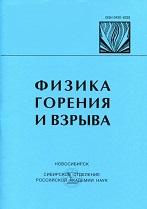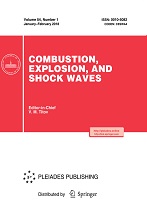|
This article is cited in 17 scientific papers (total in 17 papers)
The evolution of 100-$\mu$m aluminum agglomerates and initially continuous aluminum particles in the flame of a model solid propellant.
II. Results
O. G. Glotov, V. A. Zhukov
Institute of Chemical Kinetics and Combustion, Siberian Division, Russian Academy of Sciences, Novosibirsk, 630090, Russia
Abstract:
A quenching/sampling method was used to study the evolution of monodisperse 100-$\mu$m aluminum agglomerates and continuous particles in the flame of combustion products – composite propellant at a pressure of 0.7–8 MPa. The particle residence time in the flame was varied in the range 6–170 msec, whereas the calculated time of their combustion was $\approx$25 msec. The evolution of a burning particle is related to the consumption of metallic aluminum and the deposition of oxide in the form of a cap, which, after complete combustion of aluminum, is transformed to the final spherical oxide particle. The density of the final oxide particles was measured. The ratio of the diameters and masses of the initial metal particle and the final oxide particles was determined. Data on particle fragmentation during combustion were obtained by comparing the numbers of the initial metal particles and the final oxide particles. Considerable differences in the combustion behavior of the agglomerates and continuous particles of size 100 $\mu$m were not found. It was established that the smaller the size of the burning particle the less oxide is deposited on the particle and the more oxide is carried away in the form of oxide smoke. For 100-$\mu$m particles, the fraction of deposited oxide was found to be $\approx$0.1 of the total mass of oxide formed.
Keywords:
aluminum particle, agglomerate, combustion, evolution, fragmentation, oxide cap, final oxide particle, particle density.
Received: 26.12.2007
Accepted: 21.04.2008
Citation:
O. G. Glotov, V. A. Zhukov, “The evolution of 100-$\mu$m aluminum agglomerates and initially continuous aluminum particles in the flame of a model solid propellant.
II. Results”, Fizika Goreniya i Vzryva, 44:6 (2008), 61–71; Combustion, Explosion and Shock Waves, 44:6 (2008), 671–680
Linking options:
https://www.mathnet.ru/eng/fgv1446 https://www.mathnet.ru/eng/fgv/v44/i6/p61
|


|





 Contact us:
Contact us: Terms of Use
Terms of Use
 Registration to the website
Registration to the website Logotypes
Logotypes








 Citation in format
Citation in format 
